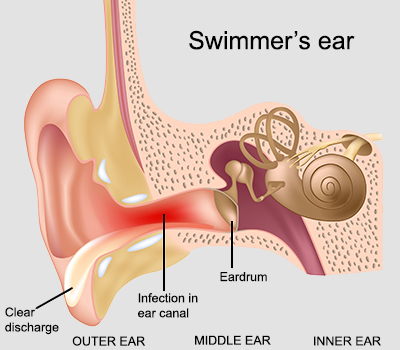What is Swimmer’s Ear ?
Swimmer’s Ear (External Ear Canal Inflammation) is a type of ear infection. Infection occurs in the ear canal. Because the ear canal is dark, warm and moist, it provides the perfect environment for the growth of water-loving bacteria and fungi.
It is called swimmer’s ear because it mostly affects people who spend a lot of time in the water, such as swimmers..
What are the Causes of Swimmer’s Ear (External Ear Tract Inflammation) Disease?
In people who spend a long time in water, those who do water sports, especially in hot weather and those who are exposed to pool water containing irritating substances such as chlorine, either water escapes into the outer ear canal or the skin of the outer ear canal gets wet due to the humidity of the environment and a very suitable environment for the reproduction of microbes is formed. Infection can be caused by ordinary infectious agents, which we call bacteria, as well as microbes called fungi.
As a predisposing factor, the habit of picking, scratching or drying the ear with ear buds and the presence of eczema can be counted. These conditions can cause dryness and fine cracks in the skin. In cases where there is water and heat from these skin cracks, microbes easily enter the skin and cause infection. If this infection is severe or left untreated, it can perforate the eardrum and spread to the middle ear.
What are the Symptoms of Swimmer’s Ear (External Ear Canal Inflammation) Disease?
Ear pain: pain that often worsens when the outer ear is pulled or stepped on; the pain may intensify and radiate to the facial side where the affected ear is.
- Itching in the ear canal
- Foul-smelling or colored (yellow, yellow/green) pus oozing from the ear
- Plugged ear
- Redness and swelling in the outer ear
- Temporary hearing loss or decreased hearing
- Mild fever
Swimmer’s Ear (External Ear Canal Inflammation) Treatment
If you suspect you have swimmer’s ear, you can do some things to relieve the pain before going to the doctor. It is helpful to put a warm (not hot) small pillow over your ear. Aspirin or another pain reliever will also reduce the pain. After diagnosis, your doctor is expected to clean the ear canal with a suction tool or cotton swab.
This can make the irritation and pain go away. The doctor may then recommend one of several treatment methods.An ear drop with a corticosteroid (to stop itching and reduce inflammation) and an antibiotic (to control the infection) are usually given. Sometimes oral pills can also be used.
Painkillers are recommended as there is severe pain. Care should be taken not to get water into the ear during recovery.If there is no visible improvement after 3 or 4 days, your doctor may prescribe antibiotics to be taken by mouth. If the causative organism is determined by laboratory tests, the antibiotic that will specifically affect it is selected.
If the external ear infection (swimmer’s ear) is caused by fungus, sulfanilamide powder is sprinkled and if it is caused by uruncolysis, it is treated with antibiotics taken orally or given as ear drops. Especially when the cause is fungus, this situation can recur many times.
What Can I Do to Prevent Swimmer’s Ear Disease?
- Keep ears as dry as possible . Place a shower cap over your head to prevent water or shampoo from getting into your ears.
- Place a cotton ball in your ear, but do not push it in. Use a dry towel to dry your ears after bathing or swimming. Use earplugs if you do water sports or are in the water frequently.
- Turn your head from side to side after getting out of the water . This helps water drain out of your ears.
- Do not insert anything into your ear canal. This includes pens/pencils, fingers, wire clips or cotton-tipped swabs. (Swabs should only be used to dry the outer ear.)
- Do not swim in dirty water.
- Do not swallow the water you swim in.

